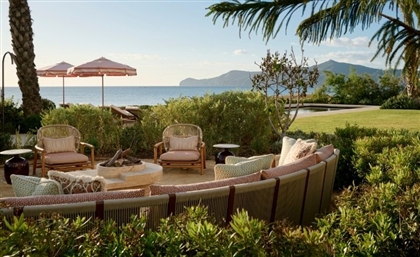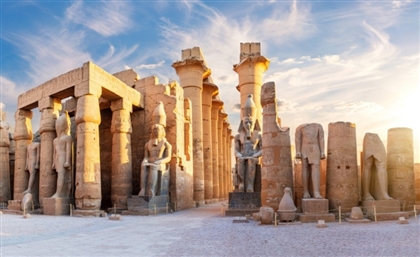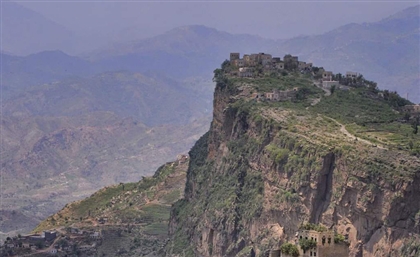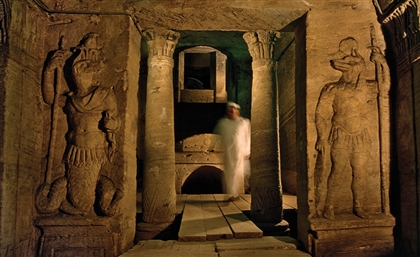Majesty & Splendour at the Middle East’s Most Historic Hotels
From seaside retreats to exquisite palaces, these historic hotels and royal residences celebrate the enchantment of the past.
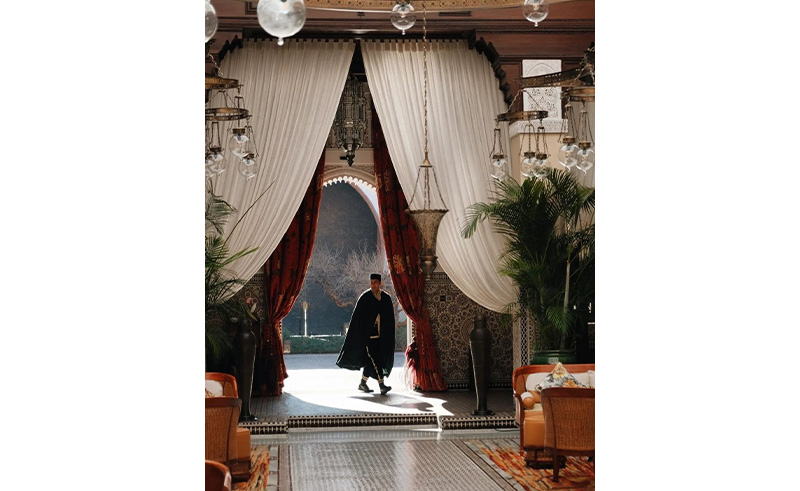
The Middle East has always had a historic reputation for over-the-top opulence and exquisite luxury. With an ever expanding collection of ultra-chic hotels popping everywhere from Qatar to Casablanca, SceneTraveller is looking to the past for inspiration, exploring the region’s most charming heritage properties - from seaside retreats to exquisite palaces - and the lost traditions of luxury they represent.
Since the mid-19th century with the opening of Cairo’s Shepard’s Hotel, a Nile side bastion of luxury that would set the standard for hospitality well into the 20th century, the region’s nascent tourism industry grew dramatically with the advent of steamships and railroads connecting Europe to the Middle East. Guests would alight for month long expeditions across Egypt and the Levant and there to greet them at whichever far off kasbah would serve as a Grand Hotel – destinations of elegant enchantment.
While many of these historic hotels are but a far off memory, the legends live on. The hotels below characterise the glory days of the past, as well as the unique efforts being made to revitalise history and celebrate heritage.
Royal Heritage
Sofitel Winter Palace Hotel | Luxor, Egypt
On Luxor’s East Bank there is but one hotel, a grand dowager of faded glory and legendary acclaim– The Winter Palace. Majestically rising above the silver flow of the Nile, and in the southern shadow of Luxor Temple, this three-tiered Edwardian confection served as the former winter retreat of King Farouk and his royal court, as well as a colourful cast of high society, artists and intrepid archeologists. Quite possibly its most famous guests were Lord Carnarvon and Howard Carter, who upon the discovery of Tutankhamoun’s tomb announced their finding to the world here – and thus catapulted the Winter Palace to international acclaim. Both the city of Luxor and the hotel itself were to become so engulfed in “Tut Fever '' that the hotel had to set up canvas tents in the garden with army cots to accommodate the hordes of tourists eager to discover more about the boy king and Carter’s famous discovery.
A stay at the Winter Palace is a sedate affair and an elegant respite from the frenetic city outside its doors. While long past its heyday, the hotel has an undeniable charm and true sense of history. A noble silence fills the halls, with hushed Victorian lounges, fraying Oriental carpets and dusty chandeliers. However, the lobby’s ornate marble staircase and the winding white terraces overlooking tropical gardens are as beautiful as when the palace first opened its doors, either in 1886 or 1907 - who can know for sure as the legends vary.
While so many of Egypt’s historic palace hotels have undergone renovations, the Winter Palace - despite the 1990 addition of ‘The Pavilion’ annexe - feels untouched by time, the last true vestige of a golden era. Just as in the past, the hotel welcomes dusty tourists, weary and sweating from days spent in the Valley of the Kings. For the last 100 years the Winter Palace has been witness to the whispers of travellers recounting their days spent in the glory of the ancient kings, dreaming about hidden treasure and the afterlife yet to come.
Cairo Marriott Hotel & Omar Khayyam Casino | Cairo, Egypt
Constructed over 150 years ago, Qasr Al Gezirah - located on the island of Zamalek - was commissioned by Khedive Ismail to entertain visiting royalty and foreign dignitaries during the opening of the Suez Canal in 1869. The palace has long been noted for the harmony of its neo-classic proportion together with an interior and facade decorations recalling the Alhambra Al-Andalus. Rumour has it the palace was constructed as a token of love by Khedive Ismail for the French Empress Eugenie. It is said that theirs was a love sworn at first sight and in the golden bedroom designed exclusively for the Empress' pleasure, where the Khedive placed a ruby above the bed with the inscription, “My eyes will at least admire you forever.”
Over the course of the century, the palace would change hands and names numerous times. After Egypt’s nationalisation policies of the 1950s, Qasr Al Gezirah was re-christened as the Omar Khayyam Casino and would later see the addition of two massive tower blocks accommodating the property’s astonishing 1,000 or so rooms. Under the direction of the Marriott, that palace would undergo a series of renovations to the historic interiors which now serve as the hotel’s public reception rooms. The splendour that Khedive Ismail envisioned as a symbol of his love remains intact with heavy crystal chandeliers, soaring halls, elaborate woodwork, polished marble and the undeniable presence of royalty.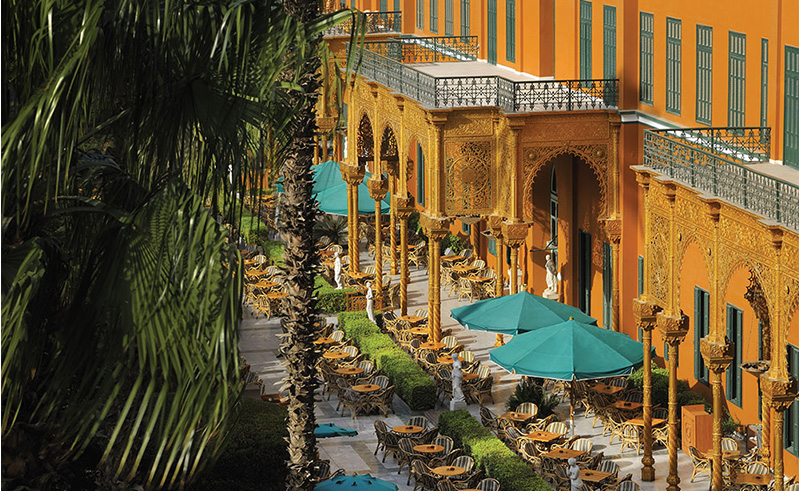 The American Colony Hotel | Jerusalem
The American Colony Hotel | Jerusalem
A long time favourite of diplomats and journalists, the American Colony Hotel is located directly on the seam line between East and West Jerusalem, and has historically advocated for peace within the fractured Holy City, welcoming everyone, no matter where they come from or what they believe in.
Built in 1860 by Ottoman Pasha Rabbah Daoud Amin Effendi al-Husseini, the home was gradually extended to accommodate individual wings for his four wives. After the Pasha’s death in the 1880s, a group of American evangelicals purchased the palace with the intent of founding a utopian community, which they christened The American Colony. In 1902, the messianic commune was purchased by a Jaffa hotelier and transformed into Jerusalem’s most luxurious hotel. Throughout the course of the century, the hotel would play witness to seismic negotiations, while remaining a place of respected neutrality, as well as cementing its continued status as the city’s number one hotel – not an easy feat by any means.
Of the 94 rooms present within the hotel, no two are alike. Pasha’s Effendi original apartments (Room no. 1) remain intact, while many other rooms feature painted ceilings, graphic marble inlay, elegant furnishings and striking oriental carpets . The American Colony’s four elegant sandstone buildings (two of which are connected via a wrought iron staircase) are situated within three lush Mediterranean gardens – The Courtyard Garden, The East House Garden, and The Palm Garden – accessed through the hotel’s iconic vaulted foyer. The hotel is located within walking distance from the Dome of the Rock, the Wailing Wall and the Holy Sepulchre.
Marriott Mena House | Cairo, Egypt
Located in the shadow of the Great Pyramids of Giza, the hotel has captivated the imagination of visitors ever since its opening by Khedive Ismail in 1869. The 40-acre property was envisioned as a hunting lodge and later would boast Egypt’s first hotel swimming pool. After changing hands to a wealthy English family in 1883, the former royal residence was named Mena House, after the first pharaoh Menes who united Upper and Lower Egypt. First a royal residence and later a playground for the rich and famous, the hotel was noted for its remarkable architecture and the beauty of its interiors, and of course, for the Pyramids right next door.
Throughout its history the hotel has played host to some seriously illustrious guests. Winston Churchill planned strategic moves from the hotel’s verandah, while President Sadat worked to broker a peace with Israel in the hotel's halls. Frank Sinatra performed ‘Stranger on the Nile’ in the garden, while Umm Kulthum was known to sing until morning during her frequent visits. The Shah of Iran spent a doomed honeymoon there with Egypt’s Princess Fawzia, and King Farouk hosted some of the 20th century’s most lavish parties. Bulgari and Balmain staged fashion shows on the lawns, and Hollywood actors rode horses into the lobby. There are luxury hotels and there are legends: the Mena House is in a category all its own.
The Mena House is a landmark property in Marriott's expansive portfolio and is one of Egypt’s most iconic hotels. With 330 rooms spread across the historic Palace Wing and the modern Garden Wing, the property boasts three restaurants - including the Mughal Room with its spectacular views out onto the Pyramids, and the Sultan Bar in all its vintage splendour - alongside an 18-hole golf course and terraced pool spilling over three levels amidst gardens of flowering trees and noble palms.
Çirgan Palace Kempinski | Istanbul, Türkiye
Rising along the Bosphorus, the incredible Çirgan Palace is a baroque vision of sumptuous Ottoman architecture with its delicate carved marble facade and famous hospitality. Originally a summer palace built for the Sultan Abdulaziz, it was regarded as one of the Empire’s most striking mansions and the height of luxury when it was constructed in 1863. The palace would serve as an official royal residence until 1910 when a great fire swept through its halls, leaving only its gorgeous facade intact. The Çirgan Palace would remain a ruin for nearly 100 years, its gardens serving as a practice field for the neighbouring Beşiktaş Football Club. In the last 30 years since its conversion into a luxury hotel, the Çirgan Palace has reigned supreme as one of the most luxurious hotels in the world.
There are 313 guest rooms in the palace. Its most illustrious suite, The Sultan Suite, goes for a nightly rate of USD 35,000 and boasts sweeping views across the Bosphorus, living room and 12 person dining room, alongside a guest bedroom and marble hammam. The Çirgan is all about ostentation and it pulls out all the stops in making guests feel like royalty: gilded mirrors, sprawling Persian carpets, 30 foot chandeliers, and oversize Ming vases all amidst a colour palette of imperial reds and soothing beige. Each room is a reflection of the palace's historical position between East and West, deftly pairing intricate painted ceilings and Islamic tile-work with Baroque moulding and 19th century furnishings. The result is a sumptuous expression of the long lost glory of the Ottoman empire.
Intimate Heritage
While not palaces per se, the hotels below represent a more sensitive connection to the past– whether it be in their historic position and unique architecture or the storied lives of their previous owners.
Manouchehri House | Kashan, Iran
The city of Kashan, a historic centre along the Silk Road famed for its production of silk textiles and hand knotted Persian carpets, has a heritage spanning millennia. With a cityscape characterised by sprawling mansions and fairytale gardens, the city has long held a cherished position in the Persian imagination. Sadly, over the years, the fortunes of its inhabitants dwindled until little remained of its impressive collection of Safavid palaces - that is, until the restoration of Manouchehri House 2007 by owner Saba Manouchehri and architect Shahnaz Naer.
The two women, employing the talents of local artisans, set out to restore the mansion to its former glory along more contemporary minimal lines. Shortlisted for the Aga Khan Award for Architecture, the property was the first boutique hotel to open in Iran and inspired a series of similar heritage restoration projects across the city, transforming neglected palaces into private residences, libraries, galleries and cultural centres.
Conceived as a means in which to reinvigorate traditional Persian heritage, Manoucheri House was little more than a ruin when work began. The eight-room property was built in the middle 18th century by a wealthy merchant who amassed a fortune in the trading of Kashan’s famed silk brocades. Manouchehri House consists of a series of elegantly appointed salons and verandahs built around a central courtyard. Fruit trees shade a shallow pool leading to the mansion’s vaulted iwan, a traditional two-storied loggia used for entertaining and the soul of any classical Persian home.
The hotel features soaring vaulted ceilings, intricate stained glass windows and elaborate stucco work, alongside block printed linens, carved wooden beds, and hand woven carpets. The most impressive feature of the restoration however was the inclusion on Saba Manouchehri’s part of a community weaving atelier employing three master weavers in the production of traditional velvets, silks, and brocade. The hotel regularly hosts weaving workshops as part of an ongoing exchange of artisanal traditions.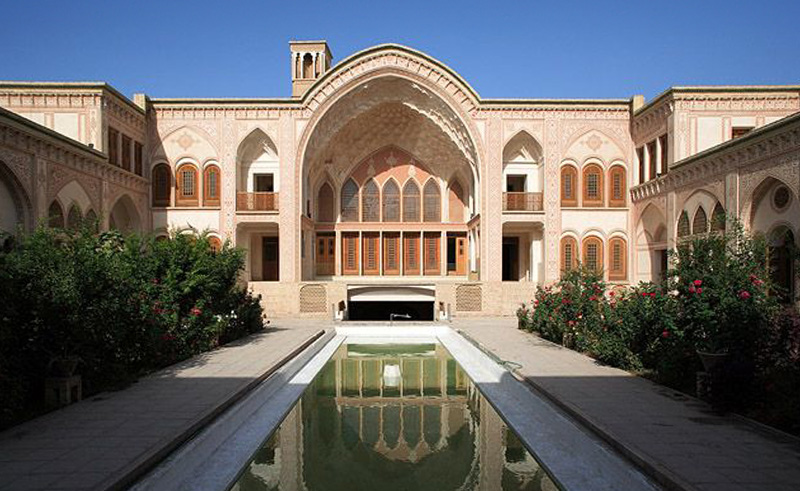 Beit Al Mamlouka Hotel | Damascus, Syria
Beit Al Mamlouka Hotel | Damascus, Syria
Located within the ancient cobbled streets of Damascus' old city, Beit Al Mamlouka is a labour of love, whose doors remain open despite the ravages of war. In 2005, the owner of Beit Al Mamlouka - as part of her Ph.D. thesis on Islamic art and archeology - spent three years renovating this 17th century Damascene merchant’s palace. The result: an eight-room jewel box in the ‘oldest inhabited city in the world’.
The stunning attention to detail paid in the historic mansion’s renovation is a tribute to Damascus' unique architecture and history of exquisite workmanship. A narrow corridor, dahleez, enters into a courtyard of fragrant lemon and jasmine, centred around a bubbling fountain and polychrome marble floors. The 230-year-old archway, built in the classic white and black masonry characteristic of Mamluk period, opens into the traditional iwan, an informal living room with deep seating in which to take refuge from the sun. For centuries Damascene families lived amidst these peaceful surroundings, treasuring a style of living that has been all but lost.
Each of the eight suites have been named after important figures in Arabic and Islamic history. The Suleiman Suite is adorned with delicate frescos dating from the 17th century covering both the walls and ceilings, while rich woodwork, stained glass, and soaring archways are characteristic of other rooms. Traditional brocades, damascene quilts, and hand painted tiles are part of the delicate attention towards detail present throughout the property. The current owner of Beit Al Mamlouka has, in the years since taking over the property, renovated a second ancient home – Dar Al Mamlouka – alongside an Ottoman-era bathhouse for guests to enjoy.
Palais Bayram | Tunis, Tunisia
Along the winding lanes of the Tunisian capitals fabled medina there are many treasures to be discovered, but none as gorgeous at Palais Bayram. Purchased in 1883 by Sheikh Al Islam M’hammed Bayram, this extraordinary house has a pedigree going back nearly 400 years. Famed for its exquisite tile work, coffered ceilings, gilt woodwork, marble inlay, and delicate stucco work, the property opens onto three distinct courtyards, each filled with fountains and gardens typical of Tunisian homes. Opening as a hotel in 2015, the Palais is one Tunis’ few heritage hotels, which unlike nearby Morocco has historically opted for larger resort style accommodation rather than investing in heritage preservation.
The Palais Bayram offers 16 rooms, including the grand historical suites with their opulent ottoman tile work and crystal chandeliers. No two rooms within the hotel are quite the same and each tells a different story of Tunisia’s design heritage - Napoleonic standard rooms with white wainscoting and neoclassical mouldings are in elegant contrast to the oriental splendour of the heritage suites. Art Deco furniture, velvet sofas, antique beds, oriental carpets and stained glass windows are design hallmarks crafting a feeling of royal elegance. Palais Bayram’s Iznik tile collection of blue faience from the early 17th century is quite possibly one of the most impressive visible in a hotel and makes any stay feel like one night amidst a thousand and one.
Deir Al Oumara | Deir Al Qamar, Lebanon
Nestled within Lebanon’s Chouf mountains, the charming palace of the Ottoman Emir Basha II is a bucolic retreat of 19 rooms built in 1827. Retaining the traditional elementals of the original, itself modelled after the 18th-century Beiteddine Palace nearby, Beit Al Oumara is spread over two stories, whose turquoise trimmed windows look onto an open air patio with flowering jasmine and an octagonal Ottoman fountain. Guest rooms, public receptions and the hotel’s restaurant, Soufrat al Oumara, open onto a series of distinctive stone arcades running the length of the building.
The hotel is proud of its countryside appeal and has been decorated in a provençal style that speaks to Lebanon’s French past, while maintaining a strong connection to its Ottoman spirit. Beit Al Oumara was the home of one of Lebanon’s most powerful Emirs and served as his feudal seat until his exile by the French in 1840. In the interim 150 years the palace was extended and housed Catholic missionary activities, later becoming one of Lebanon’s premier educational institutions.
Today there is a sense of history in the walls, but this hotel is neither about luxury or ornate architecture. Its colourful and breezy rooms come complete with country-style furnishing and bright floral printed linens; the central patio feels more like a provençal piazza than that of a palace. A stay at the nearly 200-year-old Beit Al Oumara is about comfort and cosiness, and about the ingredients central to the Lebanese culture of hospitality: family, friendship, long lunches, late night dinners, and never-ending conversations.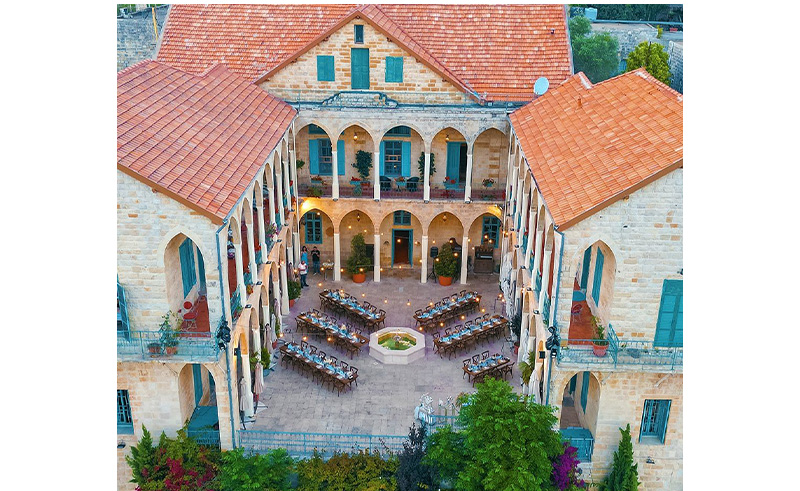 Kasbah Toubkal | Imli, Morocco
Kasbah Toubkal | Imli, Morocco
Deep within the Atlas Mountains and a 15-minute hike from the nearest village, an ancient kasbah perches along the ridge, commanding views of the snow-capped peaks and the valleys below. The Kasbah Toubkal is located in the fortifications of a tribal baron’s summer castle and has made a name for itself as the ideal location from which to enjoy quiet days, starry nights and challenging treks into the mountains.
While only 45 minutes from the splendours of Marrakech, this mountain retreat feels worlds away from the city’s ornate riads and bustling souq. This is a place of rustic charm, in the surroundings of Toubkal National Park, and pays homage to the unique culture of the Berbers - providing guests insight into a wholly different Moroccan experience than typically witnessed. This is mountain living pure and simple, albeit with the ample comforts of home.
In the years since its founding, the Kasbah has been recognized as one the world’s premier trekking hotels and provides the perfect base for day trips and overnight adventures into the mountains. Long days in the mountains end with luxurious soaks in candle lit bath tubs and delicious evening meals of hearty Berber food prepared by local villagers. The Garden Apartment is the hotel’s only suite with 12-metre glass walls looking out toward Jebel Toubkal, alongside a comfortable lounge and expansive terrace.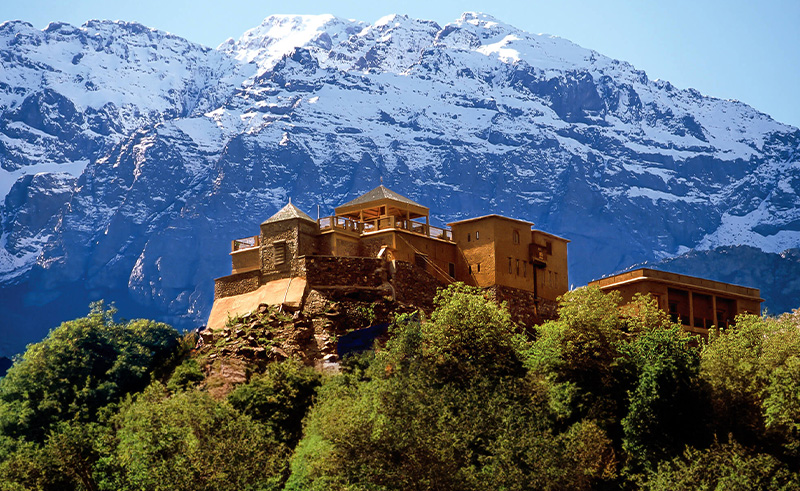 Villa Mabrouka | Tangier, Morocco
Villa Mabrouka | Tangier, Morocco
Once the former summer residence of French couturier Yves Saint-Laurent, this 1940s modernist villa is a stunning oasis located in the bustling heart of the Tangier’s Kasbah and Medina. The house uniquely combines English countryside aesthetics with Moroccan design elements and mid-century proportions that are sensitive and minimal in its approach.
Tangier has long attracted a long list of luminaries including Mick Jagger, Andy Warhol, and other members of the jet set elite. Designer and hotelier Jasper Conran set out to revive this iconic landmark through a thoughtful renovation true to the villa’s 20th century heritage and in the process created his own vision of paradise.
Villa Mabrouka’s true soul lies in its gardens. Floor-to-ceiling glass windows and moorish arches allow dazzling light to filter into the internal spaces, while commanding sweeping vistas across the sea and connecting the pared-back interiors onto romantic gardens. Saint-Laurent, together with Madison Cox, designed a series of cascading terraces which Conran later transformed with the addition of palms, bamboos, bougainvillaea, and mature citrus. The property features two pools: a turquoise tiled dipping pool and curvilinear swimming cut into the rock. Alongside three restaurants, an elegant bar, and traditional hammam the gardens encourage guests to let fantasy reign. Villa Mabrouka is not about opulent ostentation, but instead the simple pairing of beauty within a secluded and rarified setting.
Contemporary Heritage
This last category represents a new future for luxury, one that looks to the past rather than the future for inspiration. While some have been built entirely new, others are unique conversations with the past. Each project proposes a different vision for what heritage can look like in the 21st century.
The Soho House Istanbul | Istanbul, Türkiye
Surely you have never heard a story like this before. Hidden down a side street in Istanbul’s elegant, turn-of-the-century Beyoğlu district are two buildings, seemingly disconnected. One is a four-story glass and brushed steel box in the style of Mies van der Rohe, while the other stands as an ornate Italianate palazzo, upon which a neo-classical pediment is carved the official seal of the United States.
The Palazzo Corpi was constructed in 1882 for a wealthy Genovese businessman upon which no expense was spared. Richly decorated with Italian marble, brass balustrades, detailed frescos, and soaring stained glass windows, the palazzo’ owner would die shortly after its completion. In 1907, the then current American ambassador bought the palace outright to be used as the official United States Embassy to the Ottoman Empire, believing the American government would reimburse for the sale - to which the government flatly refused.
To make a long story short, the ambassador, inviting visiting senators to a game of poker, bet his congressional competitors that, if he won, the government would reimburse for his acquisition of the palace. To everyone’s surprise the ambassador played the winning hand and the Palazzo Corpi gained the unique distinction of being the first and only US mission to be won in a poker game.
The Soho House is a private members club, with an archipelago of gorgeous contemporary hotels and clubhouses across the world. While normally for the exclusive use of members, the Istanbul House has alway opened its doors to outsiders, a true blessing when considering the Beyoglu mansion has long been considered the group’s premier property. The original Capri palazzo has been transformed into a luxurious clubhouse, the grandeur of the space an experience in itself. Three floors of salons, cocktail lounges, reading rooms, and cosy dining nooks craft a feeling of an Ottoman speakeasy. The quietly plush environment nightly is transformed into Istanbul chicest insider’s secret with a regular program of dance parties, exhibitions and album premiers.
The modernist Soho House is a chic companion to the historic palace and comes complete with a host of sexy suites, bold contemporary art in a setting that effortlessly combines a sedate English country club with the hedonistic rock-n-roll flair. Alongside three restaurants, an award winning spa, and a basement cinema, a rooftop pool boast, quite possibly the best views across to the Golden Horn and the fabled Sultanahmet quarter. There is no place quite like Istanbul, and there's really no experience as cool as a stay at the Soho House.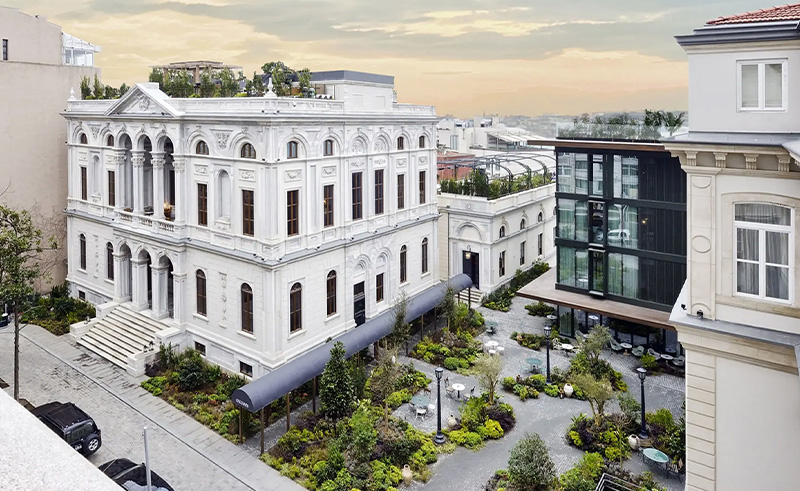 Dar Ahlam | Skoura, Morocco
Dar Ahlam | Skoura, Morocco
Hidden deep within groves of date palm at the edge of the Moroccan desert rises the House of Dreams. Housed within a 200-year-old country kasbah, Dar Ahlam - with its high walls, secret passageways, and hidden terraces - unconventionally mixes theatre and boutique accommodation.
The project in its entirety was envisioned as a dialogue between traditional aesthetics and French design sensibilities. Dar Ahlam’s founder, Thierry Teyssier. Originally trained in the theatre, he fell in love with the surroundings of this little touristed region and set about building a hotel in tune with the heritage of the land. Believing that experience and connection are the sole reasons for travel, Dar Ahlam instils a theatrical wonderment in visiting guests. In its past 20 years, Dar Ahlam has become one of Morocco’s most sophisticated retreats favoured for its authenticity, spirit, and committed approach to heritage preservation and artful hospitality.
Each of Dar Ahlam’s 14 eclectic rooms are a different expression of Teyssier’s imagination, bearing an eclectic, nomadic melange of gorgeous objects and hand crafted furniture. The decor changes with the seasons: heavier curtains and carpets laid down in winter and Moroccan cashmere shawls hanging in each closet. Setting a scene is the central motif of the hotel. There is a main salon, but there is no lobby, nor dining room. Rather each meal is served in a new setting: sometimes under the swaying palms, other-times in cosy alcoves, on candle-lit terraces, within a bedouin tent , or along the kasbah’s ramparts. The hotel’s team of 100 endeavour daily to surprise guests, with every meal and every moment different from the last.
As part of Dar Ahlam’s committed focus towards mobilising tourism for the better, Teyssier has embarked on several ambitious projects towards unique heritage preservation, partnering with the Global Heritage Fund to restore a 12th century Berber mountain village. Another unique offering from Dar Ahlam is a 1,000 kilometre journey alighting from Marrakech and traversing desert, mountain and oasis in the spirit of Bedouin and Berber nomads before arriving at Dar Ahlam’s quiet luxury. Nights spent in open air, within nomadic tents, or stately appointed rooms within village homes. Everything conspired with a wish that guests leave Dar Ahlam with memories more vivid than dreams.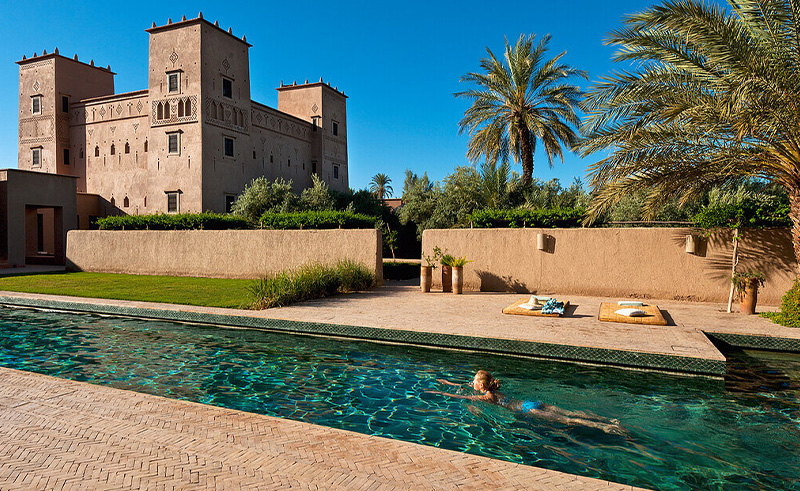 Royal Mansour | Marrakech, Morocco
Royal Mansour | Marrakech, Morocco
Morocco’s King Mohammed VI spared no expense (literally - this 2010 project had no budget) in the construction of Royal Mansour. It took 1,500 traditional artisans three years to construct the property’s 53 villas, each of which were imagined as a testament to Morocco’s artistic heritage. The resulting hotel is nothing short of splendid and quite possibly one of the most luxurious hotels in the world.
Spread out across five acres of fragrant gardens, mature forests and meandering fountains, every guest receives their own three-story riad complete with tiled courtyards, dining rooms, living rooms boasting stone fireplaces, marble hammans, and rooftop plunge pools. Velvet, suede, silver, mother-of-pearl, burnished plaster work, inlaid marble, damasks all come together in crafting an atmosphere of old world elegance and sumptuous, Moroccan splendour. And to top it all off, each riad is assigned no less than 10 staff members to see to guest’s every need.
Conceived as medina within the Medina, the Royal Mansour is a world unto its own. With so much to explore onsite, one could forgive guests from never leaving the confines of the property. With seven restaurants, including Sesamo under the helm of chef Massimilliano Aljamo, there is cuisine to satisfy any desire in an atmosphere of supreme fantasy. But quite possibly the most decadent of Royal Mansour experiences is a visit to their traditional Hamman. Centred around an elaborately carved atrium, the 27,000 sq foot temple of relaxation with its 13 treatment rooms, halls of carved marble, canopied cabanas, and glassed in swimming pool is a wonder.
A stay at the Royal Mansour is to enter into the fairy tale realm of royalty. This is opulence unlike any other and a celebration of the extraordinary power of beauty.
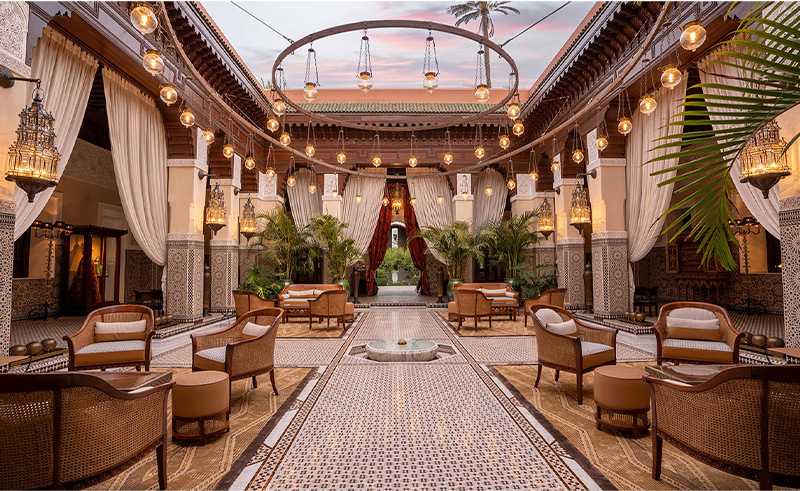
- Previous Article Six Senses Brings Children’s Wellness to Their Luxury Destinations
- Next Article Travel Across History on Egypt's Most Iconic Bridges
Trending This Month
-
Jan 10, 2026
-
Jan 08, 2026





